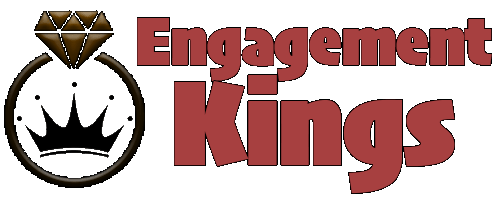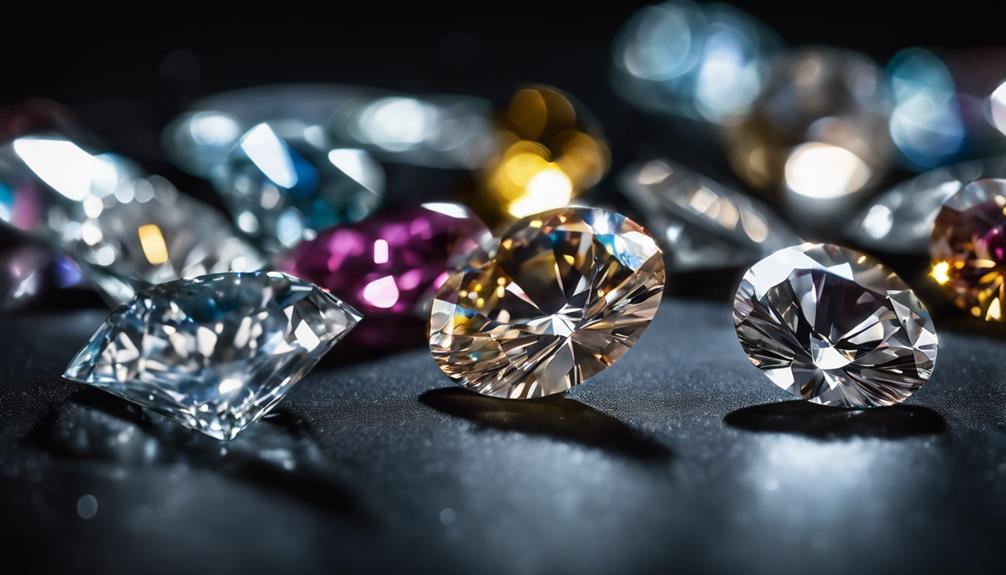E color diamonds are a fantastic choice if you’re looking for near-colorless brilliance without paying the premium for a D grade. They appear virtually identical to D diamonds to the naked eye but are slightly more affordable. Ideal settings include platinum or white gold to enhance their clarity and brilliance. Starting around $6,500 for a 1-carat stone, E color diamonds balance quality and cost. You’ll find these gems at reputable online retailers like James Allen and Blue Nile. Keep exploring to understand how diamond settings and careful selection can maximize their stunning appearance and value.
Overview and Comparison
When you’re comparing diamond colors, E color diamonds stand out as near-colorless gems that sit just below the top-tier D grade, offering exceptional brilliance and value.
Classified by the GIA within the colorless range (D, E, F), E color diamonds are virtually indistinguishable from D grade diamonds to the naked eye. You’ll notice that the differences between D and E diamonds are so slight that only a gemologist can typically detect them.
In comparison, F color diamonds are almost identical to E diamonds, while G color diamonds, although near-colorless, might show a hint of color under certain lighting conditions. H color diamonds, on the other hand, exhibit a faint yellow hue that becomes more noticeable under magnification. I color diamonds have a slight yellow tint that’s visible next to higher grades.
While E color diamonds start at around $6,500 for a 1-carat stone, G and H color diamonds provide more budget-friendly options, starting at $5,000. E color diamonds cost about 3% less than D color diamonds. G color diamonds are 10% cheaper, priced at about $4,010, and I color diamonds offer a 34% savings at roughly $2,940 compared to E color diamonds.
Recommended Settings
Platinum or white gold settings are perfect for E color diamonds, enhancing their clarity and brilliance. These metals complement the near-colorless quality of E diamonds, making them appear even more radiant.
When you choose a platinum or white gold setting, you’re ensuring that the diamond’s exceptional colorlessness is highlighted, without any yellowish tint that a yellow gold setting might introduce.
Minimalist designs work wonders for E color diamonds. With fewer distractions, the focus remains on the diamond’s quality. Settings like solitaire or bezel can effectively showcase the diamond’s natural beauty.
If you opt for a halo or pavé setting, make sure the surrounding diamonds match the E color grade to maintain a cohesive, dazzling look.
While round diamonds look great in a variety of settings, if you’re considering fancy shapes like emerald or pear, remember they tend to show color more. Sticking with platinum or white gold will keep the diamond’s colorless appearance intact.
However, if you prefer yellow or rose gold, you might consider slightly lower color grades (like G or H) since these settings can mask minor tints, maintaining an impressive overall appearance without the premium cost of E color diamonds.
Pricing and Value
E color diamonds command a premium due to their near-colorless quality and exceptional brilliance, making them a luxurious yet valuable choice for discerning buyers. These diamonds sit just below the top-tier D grade, offering almost indistinguishable beauty to the naked eye. Expect to pay around $6,500 for a 1-carat E color diamond, reflecting its high quality and desirability.
When considering value, remember that subtle differences between E and D diamonds are often imperceptible, yet E diamonds cost about 3% less. This slight price difference makes E color diamonds an attractive option for those seeking top-tier appearance without the top-tier price. Comparatively, G color diamonds offer more budget-friendly alternatives, starting at $5,000, and still appear mostly colorless.
Your decision should also factor in carat weight, cut, and clarity, as these greatly impact the diamond’s overall value. While E color diamonds offer a balance of luxury and affordability, it’s wise to avoid overpaying for unnecessarily high color grades. Often, selecting the lowest color grade that looks colorless in your chosen setting provides better value.
Ultimately, an E color diamond guarantees a stunning, near-flawless appearance while maintaining a smart investment.
Retailers and Buying Tips
To find the best value for your E color diamond, it’s important to purchase from reputable retailers known for offering certified and high-quality stones. Start by exploring well-known online jewelers like James Allen and Blue Nile. These retailers provide extensive inventories of GIA-certified diamonds, ensuring authenticity and quality.
When selecting an E color diamond, prioritize certification from respected organizations such as the GIA. This certification guarantees that the diamond meets strict quality standards. Compare diamonds side-by-side on these platforms to assess color, clarity, and overall appearance more effectively.
James Allen is renowned for its high-definition 360-degree videos, allowing you to examine diamonds closely before making a decision. They also offer competitive pricing and frequent discounts, enhancing your value for money.
Blue Nile is another excellent choice, known for its competitive pricing, generous return policy, and excellent customer service.
Additionally, don’t hesitate to seek expert advice. Many reputable retailers offer consultations with gemologists, helping you understand your options and make informed decisions.
Color Scale and Evaluation
Understanding the diamond color scale is essential for making informed purchasing decisions. Diamonds are graded from D (colorless) to Z (light color), with D to F being the most sought-after for their lack of color. E color diamonds fall just below D, making them nearly indistinguishable to the naked eye and placing them in the colorless range.
When evaluating diamonds, experts use controlled lighting conditions to detect even the slightest tint. This guarantees that E color diamonds maintain their near-colorless status, appearing pristine in most settings.
However, you should prioritize the cut quality over the color grade. A well-cut H color diamond can often outshine an E color diamond due to better light performance.
It’s important to understand that the visual differences between adjacent color grades, like D and E, are minimal. As a result, while E color diamonds are visually stunning, they mightn’t offer the best value compared to slightly lower grades, such as H or G, which can be equally beautiful in well-chosen settings.
Conclusion
Choosing an E color diamond means you’re getting near-colorless brilliance without the top-tier price tag.
You’ve learned the subtle differences between D, E, and F grades, and how specific settings can enhance your gem’s allure.
By understanding pricing dynamics and knowing where to buy, you can confidently select a diamond that balances beauty and value.
Trust your newfound knowledge and make a purchase that exceeds your expectations in elegance and affordability.



